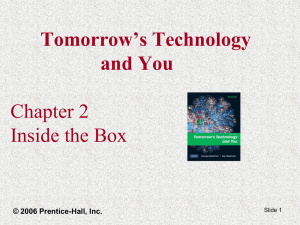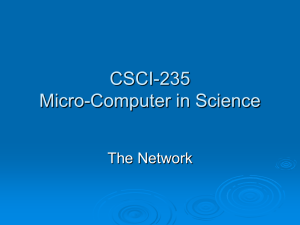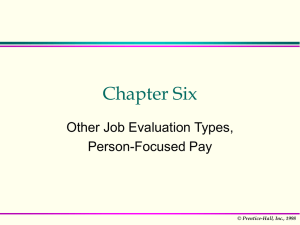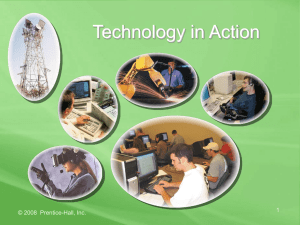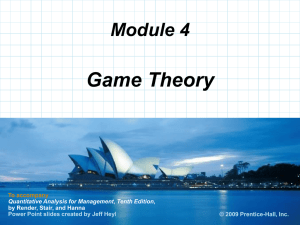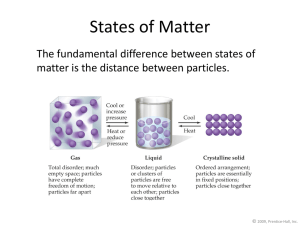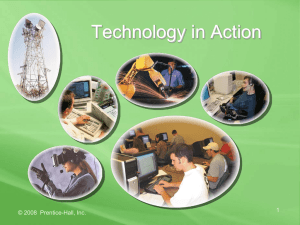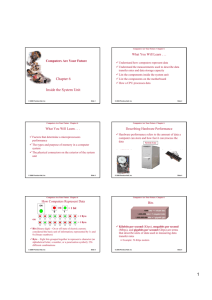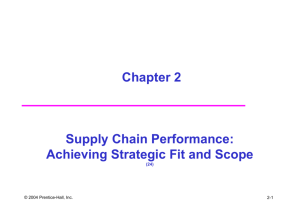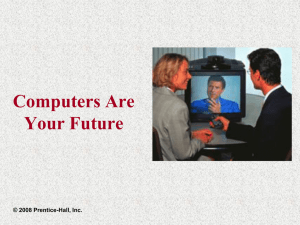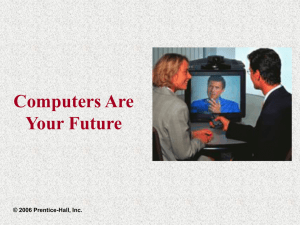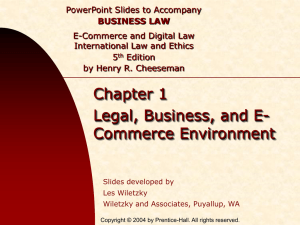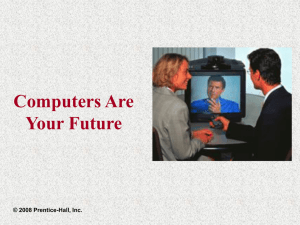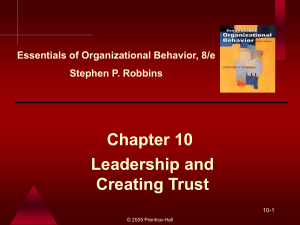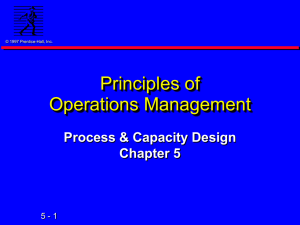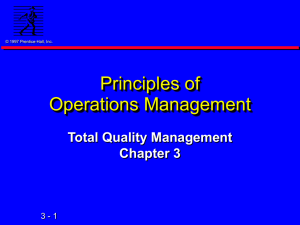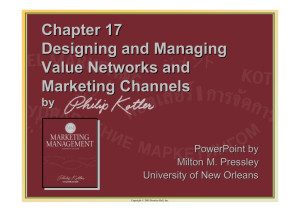1 - Computer Science
advertisement
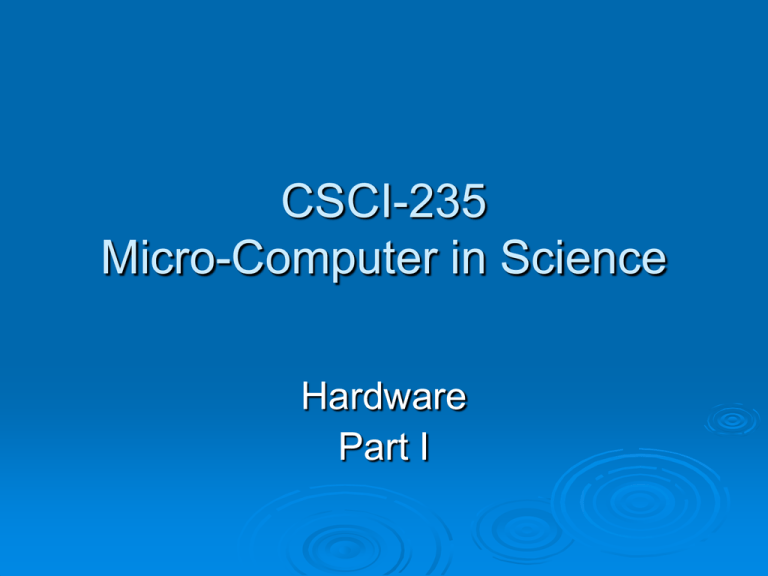
CSCI-235 Micro-Computer in Science Hardware Part I How Computers Represent Data OFF ON OFF ON OR 0 = 1 bit 1 = 1 Byte OR 0 0 1 1 0 1 0 0 = 1 Byte 0 1 0 0 0 0 0 1 Bit (Binary digit) – On or off state of electric current; considered the basic unit of information; represented by 1s and 0s (binary numbers) Byte – Eight bits grouped together to represent a character (an alphabetical letter, a number, or a punctuation symbol); How many possible combinations? © Prentice-Hall, Inc Bit Basics A On © Prentice-Hall, Inc bit (binary digit) Is the smallest unit of information Can have two values: 1 or 0 Can represent numbers, codes, or instructions Powers of 2 Bits as Codes ASCII – American Standard Code for Information Interchange Most widely used code, represents each character as a unique 8-bit code © Prentice-Hall, Inc Number Systems Decimal number system Digits (or symbols) allowed: 0-9 Base (or radix): 10 345 is really 3 x 100 + 4 x 10 + 5 x 1 3 x 102 + 4 x 101 + 5 x 100 © Prentice-Hall, Inc Number Systems (cont’d) Binary number system Digits (or symbols) allowed: 0, 1 Base (or radix): 2 1001 is really 1 x 23 + 0 x 22 + 0 x 21 + 1 x 20 © Prentice-Hall, Inc Transforming Between Bases Example Transform 36 (base 10) to base 2 Done in class © Prentice-Hall, Inc Decimal to Binary Decimal number is converted to binary by repeated divisions by 2 record the remainders Stop when you reach 0 Concatenate the remainders The order: first remainder is least significant bit 55d = 110111b Counting in binary Bits as Instructions The computer stores instructions as collections of bits. For instance, 01101010 might instruct the computer to add two numbers Other bit instructions might include where to find numbers stored in memory or where to store them © Prentice-Hall, Inc Bytes 8 bits = 1 Byte 1024 Bytes = 1 Kilobyte (KB) 1,048,576 Bytes = 1 Megabyte (MB) 1,043,741,824 Bytes = 1 Gigabyte (GB) 1,099,511,627,776 Bytes = 1 Terabyte (TB) Kilobyte, megabyte, gigabyte, and terabyte are terms that describe large units of data used in measuring data storage Example: 20 GB hard drive © Prentice-Hall, Inc Inside the System Unit Motherboard (mainboard) – Large printed circuit board with thousands of electrical circuits Power supply – Transforms alternating current (AC) from wall outlets to direct current (DC) needed by the computer Cooling fan – Keeps the system unit cool Internal Speaker – Used for beeps when errors are encountered Drive bays – Housing for the computer’s hard drive, floppy drive, and CD-ROM / DVDROM drives © Prentice-Hall, Inc The Motherboard The motherboard provides the centralized connection point for the computer’s components Most components are integrated circuits (chips) • Chips carry electrical current and contain electronic switches or transistors © Prentice-Hall, Inc The Central Processing Unit: The Microprocessor CPU CPU socket Central processing unit (CPU) – A microprocessor that interprets and carries out instructions given by software. It controls the computer’s components © Prentice-Hall, Inc Components of the CPU Control unit – Coordinates and controls all parts of the computer system Arithmetic-logic unit – Performs arithmetic or logical operations Registers – Temporarily store the most frequently used instructions and data © Prentice-Hall, Inc The Control Unit The control unit manages four basic operations (fetch, decode, execute, and write-back) The four-step process is known as the machine cycle or processing cycle The processing cycle consists of two phases: • Instruction Cycle Fetch – Gets the next program instruction from the computer’s memory Decode – Figures out what the program is telling the computer to do • Execution Cycle © Prentice-Hall, Inc Execute – Performs the requested action Write-back (Store) – Writes (stores) the results to a register or to memory The Arithmetic-Logic Unit The arithmetic-logic unit (ALU) performs basic arithmetic and logic operations Adds, subtracts, multiplies, and divides Compares alphanumeric data © Prentice-Hall, Inc What Happens Inside: Unraveling the Mystery Instruction Time Execution Time Execute Instruction © Prentice-Hall, Inc Decode Instruction Place Result in Memory Fetch Instruction The Big Picture A computer with software running on it Want to write nice abstract High level Language (HLL), have stupid computer that only knows how to execute Machine Language High-Level Language C++, Java, etc.. Machine Language Binary sequences What is machine language? Binary sequences interpreted by the computer as instructions, not very human readable The Big Picture (cont’d) To help the situation, introduce assembly language, a more human readable form of machine language Uses MNEUMONICS for the instruction type, operands • add A, B Add is the mneumonic or opcode A and B are the operands, the variables used in the instruction Now we need something to translate assembly language to machine language the ASSEMBLER Lastly, if we had a program that translated HLL programs into assembly language then we are done, a COMPILER does this The Big Picture (cont’d) HLL compiler assembly language Least detail Top level number = count + 1 add a, b, c assembler machine language Most detail Bottom level 01010010001110010101011010101010 Basic Computer Operation Memory CPU I/O CPU Controls the running of programs Executes instructions Makes requests of the memory Memory Where programs and program variables (i.e., data) are stored Handles requests from the CPU © Prentice-Hall, Inc Basic Computer Operation (cont’d) To execute an instruction, the processor must be able to request 3 things from memory: Read Instruction FETCH Operand (variable) load LOAD Operand (variable) store STORE CPU specifies an address and a read operation memory responds with the contents of the given address Write CPU specifies an address, data to be stored, and a write operation memory responds by overwriting the data at the address specified © Prentice-Hall, Inc Example 1. Fetch the next instruction 01010010001110010101011010101010 2. Figure out what the instruction is (i.e., DECODE IT) add a, b, c It is an ADD instruction, this also reveals how many operands there are 3. Load operand(s) Operands are b and c 4. Do the operation specified by the instruction ADD b and c together 5. Store result(s) (if any) Result goes into variable a © Prentice-Hall, Inc INSTRUCTION FETCH AND EXECUTE CYCLE 1. Fetch the next instruction 2. Update Program Counter (PC) 3. Decode 4. Load operand(s) 5. Do the operation specified by the instruction 6. Store result(s) (if any) © Prentice-Hall, Inc
